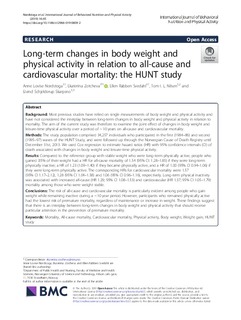| dc.contributor.author | Nordstoga, Anne Lovise | |
| dc.contributor.author | Zotcheva, Ekaterina | |
| dc.contributor.author | Svedahl, Ellen Rabben | |
| dc.contributor.author | Nilsen, Tom Ivar Lund | |
| dc.contributor.author | Skarpsno, Eivind S. | |
| dc.date.accessioned | 2019-06-03T14:58:31Z | |
| dc.date.available | 2019-06-03T14:58:31Z | |
| dc.date.created | 2019-06-03T14:19:39Z | |
| dc.date.issued | 2019 | |
| dc.identifier.issn | 1479-5868 | |
| dc.identifier.uri | http://hdl.handle.net/11250/2599774 | |
| dc.description.abstract | Background
Most previous studies have relied on single measurements of body weight and physical activity and have not considered the interplay between long-term changes in body weight and physical activity in relation to mortality. The aim of the current study was therefore to examine the joint effect of changes in body weight and leisure-time physical activity over a period of ~ 10 years on all-cause and cardiovascular mortality.
Methods
The study population comprised 34,257 individuals who participated in the first (1984–86) and second (1995–97) waves of the HUNT Study, and were followed up through the Norwegian Cause of Death Registry until December 31st, 2013. We used Cox regression to estimate hazard ratios (HR) with 95% confidence intervals (CI) of death associated with changes in body weight and leisure-time physical activity.
Results
Compared to the reference group with stable weight who were long-term physically active, people who gained ≥5% of their weight had a HR for all-cause mortality of 1.54 (95% CI: 1.28–1.85) if they were long-term physically inactive; a HR of 1.23 (1.09–1.40) if they became physically active, and a HR of 1.00 (95% CI 0.94–1.06) if they were long-term physically active. The corresponding HRs for cardiovascular mortality were 1.57 (95% CI 1.17–2.12), 1.28 (95% CI 1.04–1.58) and 1.06 (95% CI 0.96–1.16), respectively. Long-term physical inactivity was associated with increased all-cause (HR 1.29; 95% CI 1.08–1.53) and cardiovascular (HR 1.37; 95% CI 1.05–1.79) mortality among those who were weight stable.
Conclusions
The risk of all-cause and cardiovascular mortality is particularly evident among people who gain weight while remaining inactive during a ~ 10 year period. However, participants who remained physically active had the lowest risk of premature mortality, regardless of maintenance or increase in weight. These findings suggest that there is an interplay between long-term changes in body weight and physical activity that should receive particular attention in the prevention of premature mortality. | nb_NO |
| dc.language.iso | eng | nb_NO |
| dc.publisher | BMC (part of Springer Nature) | nb_NO |
| dc.rights | Navngivelse 4.0 Internasjonal | * |
| dc.rights.uri | http://creativecommons.org/licenses/by/4.0/deed.no | * |
| dc.title | Long-term changes in body weight and physical activity in relation to all-cause and cardiovascular mortality: the HUNT study | nb_NO |
| dc.type | Journal article | nb_NO |
| dc.type | Peer reviewed | nb_NO |
| dc.description.version | publishedVersion | nb_NO |
| dc.source.volume | 16 | nb_NO |
| dc.source.journal | International Journal of Behavioral Nutrition and Physical Activity | nb_NO |
| dc.source.issue | 45 | nb_NO |
| dc.identifier.doi | https://doi.org/10.1186/s12966-019-0809-2 | |
| dc.identifier.cristin | 1702335 | |
| dc.description.localcode | © The Author(s). 2019 Open Access This article is distributed under the terms of the Creative Commons Attribution 4.0 International License (http://creativecommons.org/licenses/by/4.0/) | nb_NO |
| cristin.unitcode | 194,65,20,0 | |
| cristin.unitname | Institutt for samfunnsmedisin og sykepleie | |
| cristin.ispublished | true | |
| cristin.fulltext | original | |
| cristin.qualitycode | 2 | |

